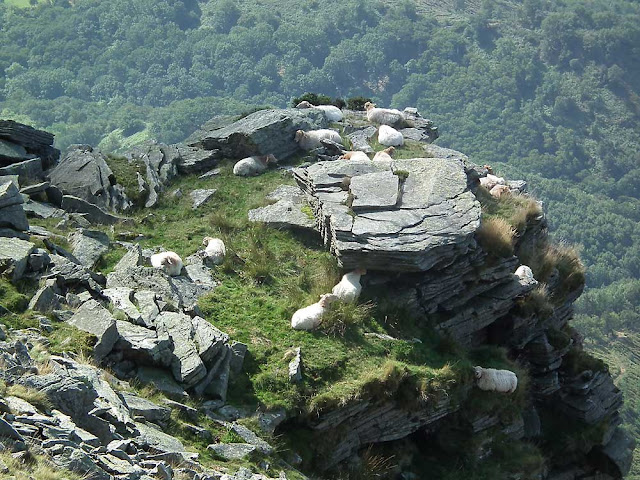The Manech tête rousse is a breed of sheep indigeneous to the French Basque country. Their origins are not fully known, but they have been raised in the western Pyrenees for a very long time, found mostly on the hillsides, and certainly developed in the Pyrenees, not imported from elsewhere during the Moorish invasions, for example. They are dairy sheep, the most productive in the Pyrenees, and their milk is most notably used in the production of the local brebis cheese (AOC Ossau Iraty, which is a type of tomme). They are sheep with hanging fleeces, white with red heads and legs. They are particularly hardy and well adapted to the transhumance and long treks along the steep slopes of the Pyrenees.
They bear no characteristics whatsoever of Merinos, and are quite different to other local breeds of sheep. Their locks grow to about 25 centimetres long. They are hornless, with long narrow faces, drooping ears and sturdy legs. A ewe will stand about 60 centimetres tall at the shoulder and weigh about 50 kilos.
The ewes are milked for 125 days of the year and in that time will produce 150 litres of fat and protein rich milk. The herds are more or less impervious to bad weather, rain as well as snow, and variations in temperature. They have trouble free births in the spring and lactate all summer. The floral richness of the pasture they eat is reflected in the milk and the end product, cheese.
Manechs are raised using a system of a short three to four month transhumance (and sometimes no transhumance at all). Lambing takes place from December to March and they are milked from December to July. It is collected by the industrial producers or processed on the farm. Milking commences when the lambs are weaned at 35 days. Lambs are sold to fat lamb producers in Spain, or raised on the farm and sold as Label Rouge agneau de lait des Pyrénées.
There is a breeding programme, established in 1975, to improve the herd. 56 000 ewes are involved, artificially inseminated with sperm from the best rams. In total the national herd is 200 000 ewes, all located in the Pyrénées-Atlantique, in Basse-Navarre and lower Soule.
************************************************
For details of our private guided tours of chateaux, gardens, wineries, markets and more please visit the Loire Valley Time Travel website. We would be delighted to design a tour for you.
We are also on Instagram, so check us out to see a regularly updated selection of our very best photos.
We are also on Instagram, so check us out to see a regularly updated selection of our very best photos.




4 comments:
They also seem to be sure footed and not prone to fear of heights - acrophobia!
That middle photo is good, isn't it?! I would have hesitated to climb down to there from where the photo was taken, that's for sure, and the casual way they are just laying about is impressive.
We are looking for Manech ewe lambs to tup in the autumn 2022, can someone put me in contact with farmers who could sell on some ewe lambs from 2022 lambing. Seeking 300 Manech ewe lambs for a new dairy set up in Wales
Anon: Sorry, I don't know anyone who farms this breed. These were taken on our holiday. And you've left us with no way of contacting you directly anyway.
Post a Comment